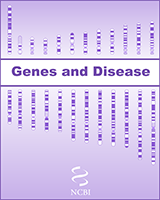NCBI Bookshelf. A service of the National Library of Medicine, National Institutes of Health.
National Center for Biotechnology Information (US). Genes and Disease [Internet]. Bethesda (MD): National Center for Biotechnology Information (US); 1998-.

Inflammatory bowel disease (IBD) is a group of chronic disorders that causes inflammation or ulceration in the small and large intestines. Most often, IBD is classified either as ulcerative colitis or Crohn's disease. While ulcerative colitis affects the inner lining of the colon and rectum, Crohn's disease extends into the deeper layers of the intestinal wall. It is a chronic condition and may recur at various times over a lifetime.
About 20% of cases of Crohn's disease appear to run in families. It is a "complex trait," which means that several genes at different locations in the genome may contribute to the disease. A susceptibility locus for the disease was recently mapped to chromosome 16. Candidate genes found in this region include several involved in the inflamatory response, including: CD19, involved in B-lymphocyte function; sialophorin, involved in leukocyte adhesion; the CD11 integrin cluster, involved in microbacterial cell adhesion; and the interleukin-4 receptor, which is interesting, as IL-4-mediated functions are altered in IBDs.
Because some of the genetic factors involved in Crohn's disease may also contribute to ulcerative colitis susceptibility, research into Crohn's disease may assist in further understanding both types of IBD.
Related diseases
- Genome view see gene locations
- Entrez Gene collection of gene-related information
- BLink related sequences in different organisms
- Research articles online full text
- Books online books section
- OMIM catalog of human genes and disorders
- Fact sheet from the National Institute for Diabetes and Digestive and Kidney Diseases, NIH
- The Crohn's disease web page information and links
- MEDLINEplus links on Crohn's disease compiled by the National Library of Medicine
- OMIMRelated OMIM records
- Crohn's disease - Genes and DiseaseCrohn's disease - Genes and Disease
Your browsing activity is empty.
Activity recording is turned off.
See more...
